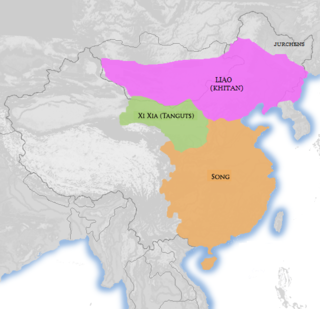
The Western Xia or Xi Xia, also known to the Mongols as the Tangut Empire and to the Tangut people themselves and to the Tibetans as Mi-nyak, was an empire which existed from 1038 to 1227 in what are now the northwestern Chinese provinces of Ningxia, Gansu, eastern Qinghai, northern Shaanxi, northeastern Xinjiang, southwest Inner Mongolia, and southernmost Outer Mongolia, measuring about 800,000 square kilometres. Its capital was Xingqing, until its destruction by the Mongols in 1227. Most of its written records and architecture were destroyed, so the founders and history of the empire remained obscure until 20th-century research in the West and in China.
The Tangut people were a Sino-Tibetan tribal union that inhabited Western Xia. The group lived under Tuyuhun authority and moved to Northwest China sometime before the 10th century to found the Western Xia or Tangut Empire (1038–1227). They spoke the Tangut language, one of the Qiangic languages that belong to the Sino-Tibetan family.

A pagoda is a tiered tower with multiple eaves, built in traditions originating as stupa in historic South Asia and further developed in East Asia with respect to those traditions, common to Nepal, China, Japan, Korea, Vietnam, Myanmar, India, Sri Lanka and other parts of Asia. Some pagodas are used as Taoist houses of worship. Most pagodas were built to have a religious function, most commonly Buddhist, and were often located in or near viharas. In some countries, the term may refer to other religious structures. In Vietnam and Cambodia, due to French translation, the English term pagoda is a more generic term referring to a place of worship, although pagoda is not an accurate word to describe a Buddhist vihara. The modern pagoda is an evolution of the stupa which originated in ancient India. Stupas are a tomb-like structure where sacred relics could be kept safe and venerated. The architectural structure of the stupa has spread across Asia, taking on many diverse forms as details specific to different regions are incorporated into the overall design. Many Philippine bell towers are highly influenced by pagodas through Chinese workers hired by the Spaniards.
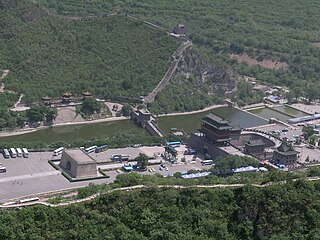
Juyong Pass is a mountain pass located in the Changping District of Beijing Municipality, over 50 kilometers (31 mi) from central Beijing. The Great Wall of China passes through, and the Cloud Platform was built here in the year 1342.

The Jetavanaramaya is a stupa, or Buddhist reliquary monument, located in the ruins of Jetavana monastery in the world heritage city of Anuradhapura, Sri Lanka. At 122 metres it was the world's tallest stupa and the third tallest structure in the world when it was built by King Mahasena of Anuradhapura (273–301). He initiated the construction of the stupa following the destruction of the Mahavihara. His son Maghavanna I completed the construction of the stupa. A part of a sash or belt tied by the Buddha is believed to be the relic that is enshrined here.

Qingtongxia is a city in north-central Ningxia, China. Administratively, Qingtongxia is a county-level city within the prefecture-level city of Wuzhong. It is located on the left (northwestern) bank of the Yellow River, opposite and a bit upstream of Wuzhong main urban area, and borders Inner Mongolia to the west.

The Songyue Pagoda, constructed in AD 523, is located at the Songyue Monastery on Mount Song, in Henan province, China. Built during the Northern Wei Dynasty, this pagoda is one of the few intact sixth-century pagodas in China and is also the earliest known Chinese brick pagoda. Most structures from that period were made of wood and have not survived, although ruins of rammed earth fortifications still exist.

Baisigou Square Pagoda was a brick pagoda in Helan County, Ningxia, China, built during the Western Xia period (1038–1227). It is situated in an isolated location about 10 km into the Baisigou Valley on the eastern side of the Helan Mountains, northwest of Yinchuan, but may have been the site of an important Buddhist temple during the Western Xia. The pagoda was illegally destroyed in 1990; archaeological investigation of the ruins has uncovered a large number of Tangut artefacts and Buddhist relics, including books and manuscripts written in the Tangut language and script.
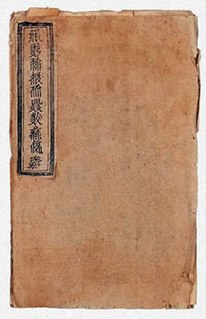
The Auspicious Tantra of All-Reaching Union is the title of a set of nine volumes of Buddhist printed texts written in the Tangut language and script which was discovered in the ruins of the Baisigou Square Pagoda in Helan County, Ningxia, Northwest China in 1991 after it had been illegally blown up.
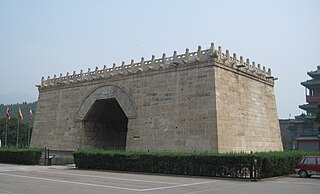
The Cloud Platform at Juyongguan is a mid-14th-century architectural feature situated in the Guangou Valley at the Juyongguan Pass of the Great Wall of China, in the Changping District of Beijing Municipality, about 60 kilometres (37 mi) northwest of central Beijing. Although the structure looks like a gateway, it was originally the base for three white dagobas or stupas, with a passage through it, a type of structure known as a "crossing street tower". The platform is renowned for its Buddhist carvings and for its Buddhist inscriptions in six languages. The Cloud Platform was the 98th site included in the first batch of 180 Major Historical and Cultural Sites Protected at the National Level as designated by the State Council of China in April 1961.

The Tangut dharani pillars are two stone dharani pillars, with the text of a dhāraṇī-sutra inscribed on them in the Tangut script, which were found in Baoding, Hebei, China in 1962. The dharani pillars were erected during the middle of the Ming Dynasty (1368–1644), in 1502, and they are the latest known examples of the use of the Tangut script. They are also very rare examples of Tangut monumental inscriptions outside of the area ruled by the Western Xia empire (1038–1227). The only other known example of an inscription in the Tangut script that has been found in north China is on the 14th-century Cloud Platform at Juyongguan in Beijing. These pillars indicate that there was a vibrant Tangut community living in Baoding, far from the Tangut homeland in modern Ningxia and Gansu, during the early 16th century, nearly 300 years after the Western Xia was destroyed by the Mongols.
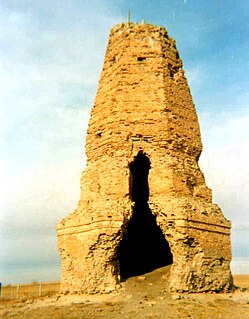
Bars-Hot or Kherlen Bars was a city built by the Khitan people, in the basin of the Kherlen River in Eastern Mongolia. It occupied an area of 1600 by 1810 metres and was surrounded with mud walls, which are today 4 metres thick and 1.5–2 metres high.

The Dafo Temple or Great Buddha Temple is an ancient Buddhist temple in Zhangye, Gansu, China, notable for its gigantic reclining Buddha statue made around 1100 during the Western Xia and Song dynasty, which is thirty-five metres long. After a restoration project in 2005–06, the Temple now attracts thousands of visitors. It has had several names over the centuries, including the "Kasyapa Buddha Temple" (迦叶如来寺), the "Bojue Temple" (宝觉寺), the "Hongren Temple" (宏仁寺), and the "Reclining Buddha Temple" (睡佛寺). The present name of "Dafo" means "Great Buddha".

The Pagoda of Chengtian Temple, meaning 'Bearing Heaven Pagoda', is an eleven-storeyed brick pagoda located on the site of a previous Buddhist temple in Yinchuan city, Ningxia, China. The pagoda was originally built during the Western Xia, but the current structure dates to the Qing dynasty. At 64.5 metres (212 ft) in height it is the tallest pagoda in Ningxia. In contrast to the Haibao Pagoda in Yinchuan, which is known as the Northern Pagoda, Chengtian Temple Pagoda is also informally referred to as the Western Pagoda.
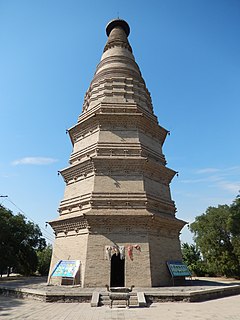
The Hongfo Pagoda, meaning 'Grand Buddha Pagoda', is an octagonal brick pagoda located in Helan County, just north of Yinchuan city, in Ningxia, China. The pagoda was built during the Western Xia, and when it was renovated in 1990 a number of Western Xia statues and printed texts were discovered.

The architecture of Myanmar, in Southeast Asia, includes architectural styles which reflect the influence of neighboring and Western nations and modernization. The country's most prominent buildings include Buddhist pagodas, stupas and temples, British colonial buildings, and modern renovations and structures. Myanmar's traditional architecture is primarily used for worship, pilgrimage, storage of Buddhist relics, political activism and tourism.

The Haibao Pagoda Temple is a Buddhist temple located in Xingqing District of Yinchuan, Ningxia, China. Because of earthquakes, the modern temple was founded in the 18th century in the period of the Qianlong Emperor (1736–1796) during the mid-Qing dynasty (1644–1911). It is the headquarters of the Buddhist Association of Ningxia.

Lingguang Temple is a Buddhist temple located on the east hillside of Mount Cuiwei (翠微山), in the Shijingshan District of Beijing. The temple is renowned for its collection of the tooth relic of the Buddha.
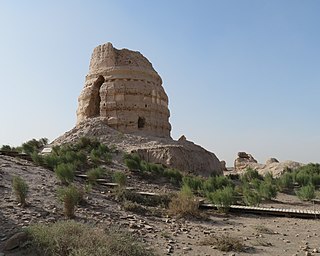
The Ta'er Temple is the modern name of a ruined Buddhist temple outside of the walls of Suoyang City in Guazhou County, Gansu, China. It has been tentatively identified with the King Ashoka Temple recorded in historical documents, which was first built in the Northern Zhou dynasty (557–581) at the latest. The extant ruins, including the main adobe pagoda and eleven smaller ones, mostly date to the Western Xia dynasty (1038–1227).





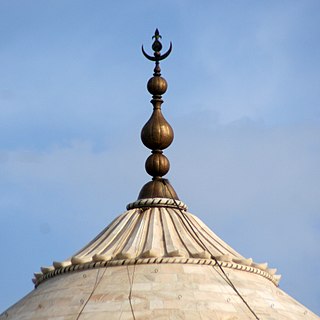

![Fragment of the Tangut version of the Thousand Names of the Buddha of the Present (Xian Zai Xian Jie Qian Fo Ming Jing ) [N11*003], found in 1987-1988 108 stupas Tangut sutra.jpg](http://upload.wikimedia.org/wikipedia/commons/thumb/a/ab/108_stupas_Tangut_sutra.jpg/220px-108_stupas_Tangut_sutra.jpg)






















